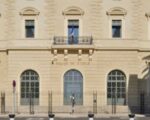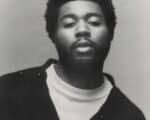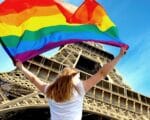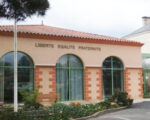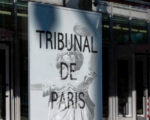>> Will gay art tour of the Vatican get the Pope’s seal of approval?
De nombreux historiens s’accordent pour dire que les peintres Michel-Ange, Léonard de Vinci et peut être Le Caravage étaient homosexuels. Les musées du Vatican regorgent de leurs oeuvres et une agence de voyage propose désormais des visites qui évoquent ouvertement l’homosexualité de ces artistes, rapporte le Guardian.
Organisées par Quiiky, une agence de voyages italienne spécialisée dans le tourisme LGBT, les visites permettent d’explorer la façon dont la sexualité de ces peintres a influencé certains de leurs tableaux.
«Devant la fresque du Jugement Dernier dans la Chapelle Sixtine, nos guides montrent les deux hommes en haut à droite qui s’embrassent pour célébrer l’ascension au paradis», explique le directeur de l’agence au New York Times.
A l’époque de Michel-Ange, de nombreux critiques avaient trouvé que le Jugement Dernier, avec son abondance de corps nus, correspondait plus à une esthétique de bains publics qu’à une peinture religieuse. Certains avaient même voulu se débarasser de la fresque. Le Guardian rappelle qu’après la mort du peintre, certaines fesses et organes génitaux ont été pudiquement recouverts par l’artiste Daniele da Volterra.
Selon l’historienne de l’art Elena Lazzarini, les corps représentés dans le Jugement Dernier avaient été inspirés par les homosexuels et les prostitués que Michel-Ange avait rencontré aux bains publics.
«Les personnages qui descendent en Enfer et montent au Paradis ont été inspirés par les travailleurs manuels virils et musclés que Michel-Ange a vus lors de ses passages aux bains publics», explique Lazzarini. «C’est là qu’il a défini la carrure du travailleur comme son idéal physique.»
Il y a aussi une visite gay-friendly de Milan, où les guides évoquent la relation entre Léonard de Vinci et son disciple Salai, qui a servi de modèle pour plusieurs représentations de Saint Jean-Baptiste, notamment dans La Cène.
Au Vatican, les guides qui parlent de l’influence de la sexualité des artistes sur leur esthétique n’ont pas été agréés par les autorités officielles. Mais Alessio Virgili, le directeur de Quiiky, assure que depuis leurs premières visites en novembre, ils n’ont reçu aucune plainte.
D’ailleurs, Virgili indique que la tolérance du Pape François a permis d’attirer des touristes homosexuels: «Depuis quelques temps, il y a une forte présence de personnes LGBT dans les musées du Vatican.»
par Claire Levenson
slate.fr
>> Visitors to Rome used to be told by tour guides that Michelangelo was “married to his art”. At least that was less shameless than the 1961 biopic that gives him a made-up girlfriend. It is a welcome sign of changing attitudes that an Italian tour company is now offering art tours of the Vatican that focus on the sexualities of Michelangelo and other great 16th and 17th-century masters.
Michelangelo was gay. Even very recently this was a controversial statement – in spite of copious visual and written evidence about his unconcealed sexual identity. Centuries of prudery and prejudice covered up the obvious, just as polite draperies added after Michelangelo’s death still cover the genitals and buttocks of some of his most potent nudes.
Quiiky, the gay travel company that is starting sexuality-themed tours of the Vatican, sees its venture as in line with the current pope’s liberal teaching … but it’s still a long way from the official Vatican perspective on art and God.
Advertisement
Michelangelo filled the Sistine Chapel with nudes that embody his passion for male beauty. Meanwhile, in the Vatican Museums that adjoin this Catholic holiest of holies, you can see paintings by Leonardo da Vinci – renowned during the Renaissance for his love of young men with long hair in ringlets and his relationships with his assistants – and Caravaggio, satirised in his own lifetime as a notorious “sodomite”.
The Catholic church and art historians besotted with religion have for a long time chosen to ignore or deny the sensual side of these artists, in spite of ample contemporary evidence that it was never a secret. Caravaggio is, today, the most contentious. Church-addled scholars insist that his homosexuality is a modern invention, the more sophisticated citing the French theorist Michel Foucault who saw gay identity and sexuality itself as modern constructs (Renaissance Italy however had a very modern notion of gay people). You can argue forever about Caravaggio because the surviving documents of his life are so slim.
This is where Michelangelo Buonarroti, so famous he gets taken for granted, suddenly takes on an exciting new character. Michelangelo left more evidence of his sexual and emotional life than almost anyone else in his age. His intense art is itself a massive document of a life torn between flesh and spirit, mind and matter. Michelangelo’s nudes are about a lot more than sex. But they make no sense without it.
Of course they express his passion for male bodies; he left written evidence to confirm it.
Michelangelo wrote hundreds of love poems that survive. The greatest are addressed to Tommaso dei Cavalieri, a young Roman nobleman for whom he conceived an unrequited passion. Other men are also commemorated in these verses hewn from a language of stone.
Renaissance neo-Platonism, a revival of ancient philosophy that saw love as the link between heaven and earth, offered Michelangelo a way of at once proclaiming and neutralising his desire. He presents himself in his poems as a lover of men, but also as pure spirit.
That didn’t stop religious zealots accusing him in his lifetime of filling the Sistine Chapel with gay art. When Michelangelo painted the Last Judgement on its altar wall, pious critics claimed his pictures were more suitable for a bathhouse than God’s house – which probably reveals a lot about Renaissance bathhouses. Soon after his death the Vatican got to work bowdlerising these nudes.
Art history added its own layers of denial, turning Michelangelo into a remote bore. Only now is the heroism of his sexuality becoming well known. Modern books about Michelangelo no longer try to claim he was married to his art. He was gay. And the Vatican should be proud.





